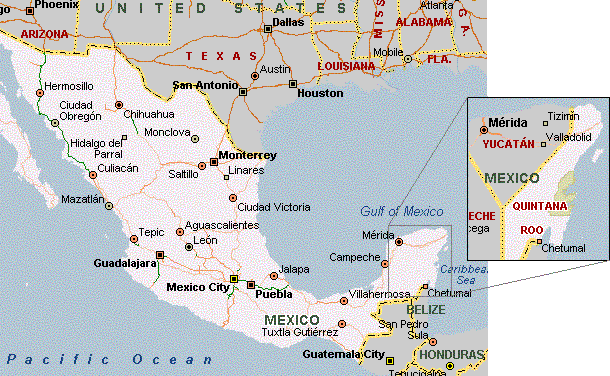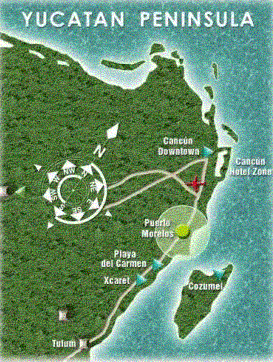It is the afternoon of the 25th of December. Christmas Day. Being European, we celebrated Christmas on Christmas Eve, leaving the 25th open for travel. We decided that would be an excellent idea. After all, who in their right mind would travel on the 25th? The trip to the airport seemed to confirm that belief. The streets are almost deserted. The trip to the airport, normally hard to make in half an hour, took us less than 20 minutes. Then however, things got a bit more interesting! Either our theory was wrong, or there are a lot of people that aren't in their right mind! Either way, the airport was a mad-house, and everything seemed to be understaffed. From shuttles to security checkpoints. But finally, we made it through it all. And the nice thing about trips like these: It was easy to get the first-class upgrade based on our elite status, since almost all the passengers were tourists that fly only once a year.
So here I am, slurping my sparkling water en-route to Cancun. Sometimes I think I should treat myself to more when I get upgraded, but I usually even turn down the food. On the other hand, airplane meals (even in first class) are not what I really consider a "treat".
I am reading my "Spanish in 10 Minutes a Day" book that I got as a Christmas present less than 24 hours ago. Being from Central Europe - with a passion for Greece, Italy, France, and what used to be Yugoslavia - I never even thought about learning Spanish, until I moved to the States. So far however, I had never been serious about it. Until now. Of course I realize that I am not going to learn Spanish on a 2 hour plane ride, but hey! you have to start somewhere, right?
The Captain informs us about the weather in Cancun. "Overcast, but in the high 70's" he says. "Cancun", I am thinking. What an unlikely place for me to go. So far, I had avoided Cancun like the plague. "Why would I want to share my vacation with a million Canadians and Americans that turn the place into a second Miami", I used to say. But Ellen changed my mind. After all, we weren't going to Cancun, but to a little town to the south called Puerto Morelos. And after all, it was just a little getaway over the holidays. We weren't there for adventure or a trip of a lifetime. And that worked for me.
I read on in my Spanish book. "Lesson 1: The Question-Words". There are seven main words and phrases one needs to form questions, it says. For instance "por qué" means "why". Why would I start out with that? What would I do if someone answered? I'd be entirely lost. I decide that "dónde" might be more helpful. "¿Dónde están los banos?". Yes, that would be useful. Everyone needs to find the bathrooms every now and then.
As I quiz myself again on a few basic phrases, we start our descent into the Cancun airport, and slowly I start to realize that I am about to go on another vacation. Entirely for relaxation this time. No business and pleasure combination that left much to be desired in the pleasure area. I am starting to get excited. The night before I didn't even really want to go. Things were to comfortable at home, and I was annoyed at the prospect of going away. That always seems to happen before I go on a trip. But I ignore that emotion since it vanishes as soon as I arrive at my destination. And after all, I didn't even have a lot of time to think about this trip. Too short was the time since we returned from Paris, and much too stressful.
The Cancun airport is small, much as I expected. Since we had first-class upgrades, we were the first off the plane, and the first through customs. Entry into Mexico is about as painless as it gets. A friendly customs officer stamps the immigration form, and off you go. They do look a little closer at the luggage brought into the country though. A simple random mechanism picks out a few unlucky travelers that get their baggage hand searched. Individuals are picked by the press of a button. If it lights up red, a search is in order. Otherwise (as was in our case), one simply walks through and is done with the formalities.
A shuttle from Olympus Tours was already waiting for us outside the airport, ready to drop us off at our final destination: The Ceiba del Mar (http://www.ceibadelmar.com) hotel and spa. Recommended to us by a friend who also happens to be a travel agent. She hadn't been there herself, but some colleges ensure that it is a great destination. And as our driver says, the hotel is "muy bien", the best in the area. Well, we will see! This is Mexico after all, and I am cautious...
The Ceiba del Mar Hotel and Spa
As we arrive at the hotel, we immediately realize that our concerns aren't justified. The entry hall is gorgeous, and kept in a very traditional style. We walk in and look around for the reception desk, but none of the tables around fit our definition of a check-in counter. There are lots of chairs and tables, and benches. Very nice design indeed. I spot the bar, and over there, they even have... "Welcome, Senor y Senorita." One of the hotel staff must have seen our confusion. "Please, have a seat.". I decline the invitation. After all, I just want to check in and get ready to start my vacation as soon as possible. "Oh, si, check-in. No problem senor. Just give me your voucher and have a seat." We hand him our papers and follow his invitation after all. Half a minute later he returns with two glasses of Champagne. "Welcome to the Ceiba del Mar hotel". The enjoyable part of our vacation had begun before I even knew it! What a nice surprise!
The check-in concept in this hotel is quite nice, and different. After all, why does one have to stand up by the counter in a long line? Here, the staff takes care of all the formalities, while the guests enjoy the hotel. A very nice touch, and a great first impression! We are hardly through half our drinks (well, OK, I am almost done with mine, but Ellen still has half a glass to go...), the formalities are taken care of, and Margarito is ready to show us to our room. Again, we are pleasantly surprised. The rooms design and furnishings mirror a variety of styles from different regions of Mexico. Everything is there, from a Minibar, to the private CD player and VCR. At this point, we are convinced! This is going to be a very pleasant vacation...
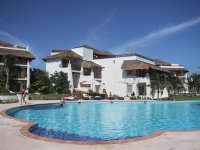
The hotel is organized in 8 smaller buildings, none higher than 3 stories. The boutique-size of the Ceiba del Mar provides a very cozy feeling. With a total of 120 rooms and 6 suites, things never get too crowded.
Margarito continues to show us around the hotel. Each building has a private terrace at the top. The terrace features lounge chairs, a private hot tub, and a bar, as well as a host. Margarito was the host of our building, and if we have any questions or wishes he says, just let him know. If we want to go on a tour, rent a car, want some food, or need any other kind of information, don't bother with the concierge. He would be our man. Oh, and by they way: When would we like our breakfast the next morning? Ahhh.... I am not quite sure. I had planned on sleeping in, and I really didn't want to get woken up for breakfast to be honest. "Yes, no problem" Margarito says. "We have two options for breakfast: You can either go to the restaurant any time between 7am and 11am, or I can bring your breakfast to your room.". In that case, he would put the breakfast into a little separate door at the outside of our room and we could retrieve it from the inside whenever we are ready. He just needs to know an approximate time, so the coffee wouldn't be cold when we are ready to retrieve it.
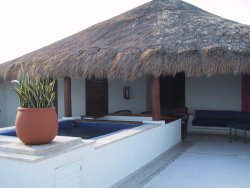
We continue on our tour of the hotel. There was the spa of course. And a workout room. Everything is very well equipped. Aside from the gym in the Westin hotel in Seattle, this has to be the best equipped workout room I have seen in any hotel! Outside there are a number of mountain bikes one could use at any time. The equipment is brand new. "Just let us know when you want one, so we know where they are...". We continue on to the restaurants. There is one for breakfast and supper. It's menu features mostly European-style food. No fajitas or tacos. And in hindsight, everything I ordered from that menu was excellent. The second restaurant serves lunch. It is down between the beach and the pool (well, one of the pools), and features a swim-up bar. It's menu is more traditional Mexican. Again, everything I ate there was outstanding.
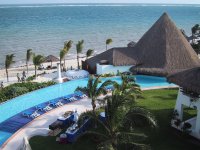
And of course, if we ever didn't want to go to one of the restaurants, the hotel also has 24 hour room service, and if we ever wanted to dine at the beach or the roof-top terrace, all we needed to do was let Margarito know.
There also are all kinds of activities offered right in the hotel. Aside from the mountain bikes, one could snorkel and scuba-dive a few-hundred yards off the hotel beach, at the Maya reef. A boat to take people out to the reef can be organized by Margarito (or any other building host) within a few hours, sometimes less. For those that do not know how to scuba-dive, instructions were available right at the hotel in the swimming pool. For those that didn't want to ride a boat out to the reef, kayaks and sailing boats are available, among other things.
As a fanatic windsurfer, I was happy to see that the hotel even had some windsurfing gear that was actually quite new and in good condition. Of course, the problem with windsurfing gear is that different sailors and different conditions require very different equipment. But the choices they made in the size of the boards and sails make a lot of sense to me and are about as good as it gets. For serious windsurfers however, I would recommend to bring your own gear. At the very least, bring a harness... I forgot mine, which put an end to my windsurfing ambitions since no harness was to be found (or purchased) anywhere in the vicinity, causing me to sit out several excellent days of sailing. Although the smallest sail I saw there appeared to be a 5.0, and that probably would have been much too large anyway. But as I understand, it normally isn't quite that windy in the area...
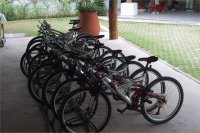
One of the things that stands out immediately at this hotel is the staff vs. guest ratio. Nowhere else have I seen this many friendly hotel employees available at all times. Be it in the restaurants, the pool or beach-side service (yes, you can get your margarita served right to your beach towel), the roof-top terrace, the library (which, BTW, features free Internet access), or the lobby. I know many supposed high-class hotels in the US and Europe that could learn a lot from this hotel.
Now let me make one thing very clear: The Ceiba del Mar is not a cheap hotel. In fact, it is the only luxury hotel in the area. And the price reflects that. However, we did not really know that ahead of time. We booked an "all inclusive" package, which wasn't truly cheap, but reasonably priced for the season. (Christmas is the busy season in the area.) So while this wasn't a low-budget vacation, I certainly think that we got an excellent value for the price we paid. I am convinced that at most popular destinations one normally pays twice the money we paid, for half the service and comfort.
I have logged many hotel-nights over the last few years. Too many in fact. (With the amount of miles I collected, I could check into a hotel in every destination on this planet for several days without even paying for it.) There are very few however where I felt as comfortable and where I enjoyed the service as much as at the Ceiba del Mar. When I return to the area, I will not look for any other hotel, but check in right back here. I would even venture as far as to say they Ceiba del Mar is my favorite vacation hotel!
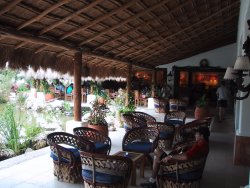
With that said, are there things I didn't like about it? Well, there are some suggestions I do have, but most of them are minor or not really the hotel's fault. When we originally booked the trip, we were told the hotel was age 16 and up. No kids. As it turned out, this was not the case. Not that big a deal, but just something I noted. We also had the unfortunate luck to have our room right next to a rather noisy bunch of guests. And while they apparently liked to go to bed early, they were also early risers. So I woke up most mornings to the repeated slamming of doors (apparently that family must have car-doors installed in their house at home). This of course is not the hotel's fault, but I certainly wished for thicker walls. Guess it's a little late for that now.
One true suggestion I have is in regards to the food that is served: While I enjoyed everything I had, I found myself wishing the dinner menu had more traditional Mexican food. When there is a buffet, why not add some fajitas or tacos? Why not add one or two Mexican dishes to the dinner menu? After all, I am here to enjoy Mexico and therefore also its culinary masterpieces. The roasted duck I enjoy, but it reminds me more of Paris than the Yucatan peninsula.
For those of you who haven't ventured into Mexico, you will be surprised how good the food is south of the border. Contrary to popular opinion, Mexican food is not just fajitas and nachos loaded with melted cheese. Try some of the different dishes, and you will be pleasantly surprised!
What To Do
Most places I go to I find myself thinking "Now that I am here, what do I do?". Here in Quintana Roo (the state Puerto Morelos is in), I find myself thinking "Now that I am here, where do I start?". There certainly is no shortage of things to do. First of all, this is the Mayan heartland. The Yucatan Peninsula has hundreds of Mayan ruins to explore. Chichen Itzá is a definite "must-see". So is Tulum, and many other places. Aside from those archeological adventures, there are many outdoor activities. Perhaps you like horseback riding or enjoy riding ATVs? How about cave exploration? Have you ever snorkeled in a Cenote (sinkhole)? Ou would you rather scuba-dive on the Maya Reef? You like the water but would rather stay above the surface? No problem: How about some deep-sea fishing? Golfing? Or perhaps you want to take things easy and enjoy a nice dinner on a replica of Columbus' ship. For party animals, nearby Cancun or Playa del Carmen are ideal evening destinations.
One of the main issues of course is how to get around. There are many horror stories about driving in Mexico, but I found them to be highly exaggerated. However, things are a bit different here, and I must admit that the Mexican way of driving may be a bit overwhelming if all you are used to is straight 5-lane highways. My experience of driving in Italy and Greece was very handy here. My recommendation: When in Rome, do as the Romans do. When in Mexico, drive as the Mexicans do. I found that the Mexican driving style is much friendlier than the American or German styles. If a car drives slower than the rest, it will pull over onto the shoulder, allowing the faster cars to pass. When an oncoming car passes another, the cars going the oposite way will again move out onto the shoulder to allow the other driver to pass safely. Of course, this means that other drivers will pass even if there is oncoming traffic. If you insist on driving like you would in your home country and not move over even a single inch, you are very likely to cause a major accident. In fact, a rental car right in front of me almost flipped over when the driver had to swerve to avoid the oncoming traffic who didn't even consider that the other car might not pull over. Similarily, you may get other drivers very upset, if you go slower than they do (and you are likely to), yet do not pull onto the shoulder to allow them to go by.
Note that Mexican law is based on Napoleonic principles, which means that one is presumed guilty unless proven innocent. And if you get into a major accident, you will probably find yourself held in Mexico, until matters get resolved (which may be a while). On the bright side, I am more comfortable driving among cooperative drivers even if things are done a bit differently.
If you are not willing to drive yourself, you have two other options: First, you can rent a driver with your rental car. Second, you can go on tours. Tours are offered to all major attractions, but of course you are stuck with a group of tourists who need to stop for bathroom breaks every 15 minutes. The tour will also drag you through a plethora of gift shops you have no interest in, and you are likely to learn (the hard way) about all the restaurants you want to avoid. And if you find something that really interests you, and you would just like to spend another 15 minutes... you can't, because the tour moves on. And for some reason, everything will appear to move in slow motion.
As you may have noticed, I am not a big fan of tours and would recommend doing things by yourself in your own (rental) car. Most places around here are easy to get to. If you go to archeological sites, or nature parks, I recommend to take a guide. Guides seem to be available at all sites and you can either join a larger tour or get a private guide. This is probably a financial decision, but if you can, I would recommend a private guide. I found them all to offer their services for reasonable prices. If I had the choice, I would probably pick non-local guides over local ones. Local guides are usually there because they need the money. Non-local guides (the further they come from, the better) are usually there because they are fascinated by what they show.
However, all the guides we had in Mexico were local. All of them were very friendly, and most of them knowledgeable. Many of them seem to be of Mayan descend, which adds to the authenticity of the tour. (I was surprised how alive and well Mayan culture and especially language still is...). Some of the stories we heard however seem to contradict each other, and it generally is a good idea to inform yourself a bit about what you are going to visit. Be aware though that no matter how much you read about archeological sites, once you are there, things generally tend to be a "pile of rubble", unless you get a guide to show you around. Some of them speak better English than others. I would say that on average, I understood about 80-90% of what they tried to communicate.
A good guide can "make or break" your experience. And if the guide was good, he will surely appreciate your tip (as would the bad guide, but hey, life is tough...).
One of the first trips we went on took us to Cobá and Tulum, two archeological sites. We had a rental car, and left in the morning right around 9AM. This gave us enough time to visit both sites in a single day. The rental car was organized by te hotel, and a representative dropped it off right at the hotel. Note however, that delivery times are tentative, and if you really want to leave at 9, you should probably order it for 8 or 8:30.
Cobá
The ruins at Cobá are not typically a main destination for most tourists. Too great is the alure of Tulum, Chichen Itzá, and Uxmal. However, we chose Cobá as our first destination for a number of reasons. Aside from being less touristy than the more mainstream sites, Cobá lies in the heart of the Yucatan jungle. Cobá also was one of the largest Mayan cities, covering 42 square miles. It is older than Chichen Itzá and Tulum, with its heyday around 600 AD. However, only about 5% of the Cobá ruins have been excavated, while the rest is still covered by the jungle. This makes for a very unique combination.
Coming from the Riveria Maya side of things (Cancun, Cozumel, Playa del Carmen,...), Cobá is easy to find. One simply drives south to Tulum and then turns north-west towards Cobá. Once off the main highway however, things get a bit bumpy, and although I feel bad about saying this, I was glad we had a rental car rather than our own. The road to Cobá features potholes like you have never seen them before. Once you reach Cobá, the ruins are very hard to miss, since there isn't much else there.
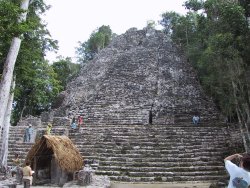
Once at the site, you will notice a network of little paths leading into the jungle. If you do not have a guide, I recommend you stick to the main paths unless you have a great sense of direction. I understand that there is a lot of wildlife to be explored there, especially birds and butterflies. Personally, I saw mostly mosquitoes, so make sure you bring some repellant. The main attraction here of course are the excavated sites (although I did enjoy looking at some piles of rocks, imagining what may lie underneath...). When you enter the site, you will first see the Grupo Cobá, which boasts a large and impressive pyramid, the Temple of the Church (La Iglesia). Although some of my travel books indicated that one could climb this pyramid, it ended up being closed to the public, and one could only admire it from the ancient square in front of it. That's not too big a problem though, because better things are yet to come...
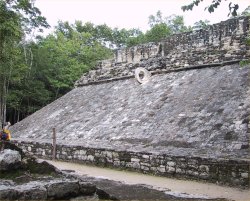
To the left of the pyramid is the ancient ball court, which was used for the ritual games. The overall rules appear to be known (the objective was to throw a ball through a vertical ring, hitting it only with hips, knees, and elbows). However, the final results seem to be a subject of discussion. Some think the winners would get decapitated, since that was a great honor for the Mayans (which sure would put a damper on the victory celebrations). Others seem to think the losers would suffer that faith. Our guide - who spoke broken English - explained to us that there was no evidence of human sacrifice in Cobá. Whether that means that there were no human scarifies in Cobá, or whether the sites where those occurred simply haven't yet been excavated, I don't know (and wasn't able to research satisfactory... there seem to be too many conflicting opinions). Either way, our Mayan amigo pointed us to a stone engraving and said "you can see - yes - that there is player - yes - who is winner - yes - and for ritual blood-letting - yes - he gets pierced his penis.". Apparently, he didn't get the reaction from us he expected, so he continued "you know, the dick!". Ah, yes. Now I understand. Gracias!
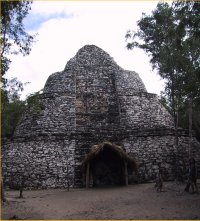
If you are familiar with Mayan architecture, you will probably notice that the architecture at Cobá is somewhat different from the architecture found at sites such as Chichen Itzá. Cobá appears to be influenced by the Tikal who were several hundred miles away, and archeologists theorize that there may have trade relationships between Cobá and far away cities. Apparently, the Itzáe from Chichen were not welcome in Cobá.
As we progress further into the ruins, we cross several sacheon (stone-paved avenues). More than 40 such roads were discovered, all elevated, straight like an arrow, and (a long time ago) covered with stucco to be bright white and allow safe travel even at night. The longest is roughly 100km (65 miles) long and goes all the way to Yaxuna, another Mayan settlement. All the roads come together at a building that was introduced to us as an observatory. And although it looked much like an astronomical observatory, we were told it wasn't used as such. As we are told, it was used for military purposes and to welcome travelers. The "observatory" appears to be one of the best preserved buildings in Cobá.
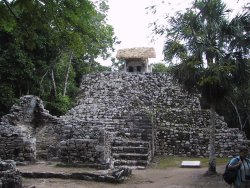
Further along the way lies the Conjunto de las Pinturas (Temple of the Paintings).It has easily recognizable traces of glyphs, frescos above the door, and remnants of colorful plaster inside. Again, this building is one of the better preserved and along with the "observatory" my favorite sight at Cobá.
The tour isn't over yet however, and we move on past some engraved stones showing more Maya glyphs (archeologists can read about 80% of Mayan writing), another ball court (no dick references this time), to the Nohoch Mul Grupo, the group of the large pyramid. It's main feature is El Castillio, the large pyramid, which is the second tallest mayan structure on the Yucatan, outdone only my structure number 2 at Calakmul. This makes El Castillio taller than the great El Castillio at Chichen Itzá as well as Pyramid of the Magician at Uxmal.
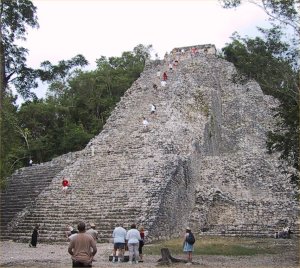
120 rather irregular steps lead to the top of the structure, and although intimidating at first (the structure isn't nearly as well preserved as the pyramid in Chichen Itzá), the climb is well worth your while and effort. At first sight, the pyramid looks very much like a large hill with stairs up the front (Cobá architectures, unlike the style found at Chichen, only features stairs at one side), but once you are on top and take a closer look, you can see that the whole thing really is a man-made structure that simply is still overgrown by the jungle. The view from the top of the pyramid is excellent. Once can see all the restored structures of Cobá, as well as the two lakes that made Cobá such a prime location for the Mayan people to settle.
Getting down is a bit harder than getting up, and for the faint of heart (and even for those that aren't), the view down the steep steps is a bit overwhelming. Although the steps are a bit wider than those at Chichen Itzá, the additional hight and the bad condition the whole structure is in make for a bit of an adventure. My tip: Don't worry about looking silly! Hold on to the rope, and if you have to, go down backwards. And hey! How often do you fall down the stairs at home?
The way back to the entrance is about 2 miles and for those in a hurry, or in bad physical condition (or simply lazy), mountain bikes as well as rikshaw rides are available. We choose to walk back though, which allows us to go on an immaginary time-journey back to the heyday of Cobá when all 6500 unexcavated structures were in tip-top condition and the city was alive, fueled by the energy of its 50,000 inhabitants.
Tulum
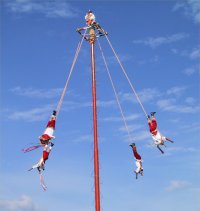
The drive from Cobá to Tulum takes less than an hour, and althought the (modern) town of Tulum is much larger than (modern) Cobá, the ruins are still very easy to find, since they are a major tourist attraction. In general, the contrast between Cobá and Tulum couldn't be greater. Where in Cobá, you pull into a small, unpaved parking lot, in Tulum you enter a major parking area where you have to pull your ticket out of a machine. Where in Cobá you can park pretty much at the entrance of the site, in Tulum you park over a mile away and have to first make your way through gift shops and souvenir stands and even past a Subway fast food restaurant (!), before you can hop on the Disney-style train that brings you to the actual site. You also have the option to walk the rest of the way, which we did and it wasn't all that far at all (however I could see that it might be quite hot in the summer...).
In the tram-stop area, we also witnessed the ancient Mexican tradition of the voladores. The idea here is that 5 men climb a pole 150 feet high (so I'm told... it seemed to be a bit less if you ask me...). 4 of the men then proceed to wrap individual ropes around the pole until only a short piece is left that they wrap around themselves. They then fall backwards of the top of the pole, spinning around it while the ropes unwind themselves. As the ropes get longer, the men get closer to the ground until they finally reach the bottom just when the ropes are entirely unwound. During all of this, the 5th man at the top plays an ancient tune using a flute and small drums. Touristy or not, I have to say that this was quite impressive.

The ruins of Tulum are much smaller than those in Cobá or Chichen Itzá. Many therefore consider them unimportant. What makes Tulum different however is that it is the only Mayan city that was located on the Caribbean coast. This turns Tulum into quite a sight. In fact, I would probably consider Tulum the most scenic archeological site I have ever visited along with Delphi in Greece (and Machu Pichu, I assume, although I haven't seen that sight myself at this point). The actual ruins are less spectacular than at other sights. They are relatively small, but well preserved/restored. One can see a few temples, sites of (human) sacrifices, catacombs, the remains of an ancient road, and even the foundations of several buildings. The main purpose of Tulum was to serve as a religious site, and there are no residential dwellings to be found there. In fact, it seems that the new parking lot has been built over the site of the ancient residential areas, and has therefore been locked away from further excavation. The site of the temples however is well excavated, and only a few unexcavated spots remain. We had an excellent tour guide in Tulum who was nice enough to take us off the beaten path and show us some of the old city walls on the far end of the area, among a few other things.
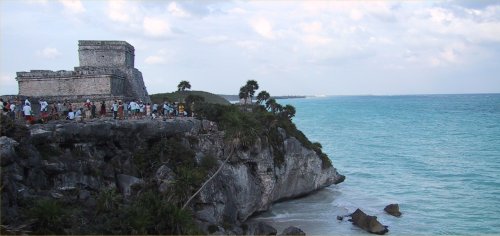
Despite the small size of the Tulum ruins, I was very impressed by this site. However, a very large number of tourists put a definite damper on the experience, and I promised myself to be back in the off-season to experience this site the "right way". One of the things that struck me as interesting was that many people seemed to go to Tulum just to "hang out". They bring some towels and make themselves comfortable at the beach just below the ruins and enjoy an afternoon of swimming, snorkeling, and occasionally even a match of soccer on the lawn in between some of the temples.
Playa del Carmen
On our way back from Tulum, we stopped in Playa del Carmen for dinner and some entertainment. This town used to be a quite fishing village that people only know from their brief stop overs before they went on the ferry that would take them to Cozumel. By now however, Playa del Carment has surpassed Cozumel as a destination. Apparently, scuba diving is just as good in Playa del Carmen as it is in Cozumel, but the nightlife is much better. I couldn't really comment on the scuba diving aspect, but there certainly is a large number of restaurants, bars, and night clubs.
We first walked around some of the busy streets and did some shopping, before we went into one of the restaurants near the beach. Since we didn't really know which one to pick, and since the area was very touristy with restaurants that try to move as many customers through as possible, our expectations weren't very high, but we ended up pleasantly surprised. The food was excellent, and the service was very good for mexican standards. And the whole setting was gorgeous, right in the middle of the town, yet close to the beach, and overlooking the main street which was filled with people.
We returned to Playa del Carmen several times. It is a great place to be if you like to party, and although I enjoyed the quiet and relaxing athmosperhe in our hotel, it was also nice to have Playa del Carmen as a livelier alternative.
Chichen Itzá
Chichen Itzá and its great pyramid probably is one of the world's best known archeological sites, and therefore - despite the unbelievable number of people - a must-see for everyone who visits the Yucatan peninsula. From Puerto Morelos (as well as Cancun), Chichen Itzá is about a 2 1/2 hour trip. The roads to Chichen are nice, but one pays a hefty fee: about U$20 is the toll each way. Add the price for the rental car and gas, it ends up being much cheaper to go on an organized tour, which is what we ended up doing. In hindsight however, I regret it, and the next time I go to Chichen, I will definitely make the trip by myself. Not only does it take much longer to get to the site, especially counting the transfer to the bus including the pickup of fellow travelers at other hotels, but my patience (which admitedly I do not have very much of) came to an end about 2 hours into the trip when we took a 30 minute break at a gift shop. Our next stop was lunch at the Maya Hotel right by the entrance of Chichen Itzá. The food quality was low average, and since it was a buffet, we really didn't need the almost 2 hours we were allowed to take. At around 2pm, I was really ready to move on. Too much of the day had already been wasted with things I had no interest in.
Unfortunately, our tour guide was a bit disappointing too. Although he claimed to do this tour 3 times a week, he seemed to be very unorganized and I got the impression he was new and had never done this tour before. Rather than taking us to the important sites, he basically showed us the great pyramid and then sent us off on our own for a while. He said that was so we could climb the pyramid inside and out (there is a smaller pyramid inside) before it closes, which supposedly happened at 3pm. However, when we left well after 5, people were still climbing up, even inside.
After we re-gathered, he gave us a tour of the ball court, and then took a vote whether we wanted to see the temple of the warriors or go straight on to the observatory. His suggestion was to go to the observatory right away, since touring the temple would add another 45 minutes to the tour. Hello?!? I thought that's what I was here for! Either way, we took a quick look at the observatory and that ended the tour. Although slightly upset with the guide, it was a relief to us, end we ended up touring the interesting parts of the site on our own.

The great pyramid (also known as the Pyramid of Kukulkan as well as the Pyramid of Quetzalcoatl) is the main attraction in Chichen Itzá. The pyramid is very well preserved, especially the two sides you always see on the pictures. Unlike the pyramids in Cobá, the great pyramid has stairs on 4 sides, which is mainly due to Toltec influence, since classical Mayan pyramids only have stairs on 1 side. In fact, inside the great pyramid is a smaller pyramid, which only had stairs on one side, and you can still get inside and climb the smaller pyramid. The only problem here is that number of people waiting to do so. When we were there, the line was perhaps 150 people long, and only 15 people are allowed inside at any time.
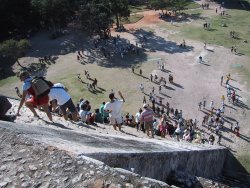
The great pyramid has 91 steps at each side. Actually, it is really 92 steps, but the last step is the platform at the top, shared by all 4 sides. Therefore, if you multiply 91 by 4 (the number of sides of the pyramid) and add the shared platform at the top, you get 365 steps, the number of days in the Mayan calendar. But this is only the first part of the intriguing astronomical allignment of the structure. The north side of the pyramid features a snake-head at the bottom of the stairs. This is the head of Kukulkan. Twice a year (at the fall and spring equanox), the exact allignment of the pyramid generates a pattern at the stairs that - in combination with the head at the bottom - gives the impression of a snake descending from the pyramid: The return of Kukulkan.
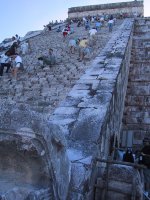
At the very top of the pyramid is a temple that (according to everyone's guess) was used for sacrifices (including human sacrifices). One can climb the stairs, and it is a bit easier that climbing the pyramids at Cobá. For one, the pyramid isn't as tall, and for the other, the steps are in much better shape. Climb the north side, since it is likely to be in the shade (and Chichen gets hot... I mean it) and most people climb the west side. Once you are at the top, the view is breathtaking since the majority of Chichen is in sight. There are plenty of great photo oportunities before you approach the somewhat daunting climb down. The steps are much narrower than those in Cobá, and quite a number of people slide down on their butts. And after all, it is much less embarassing to slide down, than to fall, right? (Not to mention the pain factor...)
Another must-see in Chichen is the ball court, which is the largest in the Mayan world. On the way from the pyramid to the ball court, you will pass several smaller temples such as the Platform of Venus, the Temple of the Skulls, and the Temple of Jaguars. Have a look at some of the ellaborate engravings. This is where a guide comes in handy. The ball court itself is impressive mainly because of its sheer size.
As you progress to the west of the ball court, you will encounter several smaller structures, such as another ball court and a smaller pyramid (Tomb of the High Priest), but the main attractions here are the Observatory (which was an actual astronomic observatory) and the Edifice of the Nuns.
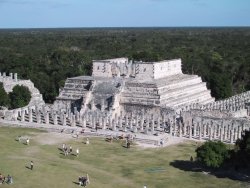
Towards the east of the great pyramid is the Temple of the Warriors. This is a very large structure that is quite impressive to visit. It got its name from all the warrior carvings that are found inside (unfortunately, one can not enter the structure). It is also known as the Group of the Thousand Columns, and it is quite easy to see why. You can go even further to the east and encounter more ball courts, steam baths, and area known as the market place, and several other structures. I enjoyed this part of the site the most, since it doesn't seem to be in the path of tours, and we found this section almost deserted. This may also have to do with the fact that it isn't truely obvious that the small paths through the jungle lead to further sites. I would highly recommend you explore this area!
Our tour of Chichen Itzá also included a night-show. My expectations weren't very high. After all, how great can a show at an archeological site be? The two just don't seem to go together very well. However, mainly due to my low expectations, I was pleasantly surprised. The light show tells you about the history of Chichen Itzá, and many of the structures. In our case, we learned more about the site during this show than during our tour. Part of the show was a "simulation" of the descend of Kukulkan, but it left me a little under whelmed. I was very impressed however, with the atmosphere of Chichen Itzá at night. There are very few other lights around (well, before the show starts that is), and seeing the ancient structures under a cloudless sky full of stars was very impressive, and I wished I could see the site like that, but without all the people.
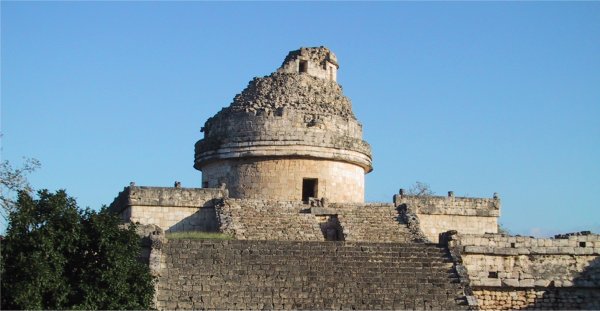
The show attracts a large number of people, and seating is very limited. Therefore, you are literally forced to run in (and not just a leisurely jog either) once the doors are opened. Apparently, people do get trampled every so often.
Aktun Chen
The day after our trip to Chichen, we rented another car and drove south towards Tulum again. This time, our destination was Aktun Chen, a wildlife park and cave system that, unlike Disney-style parks such as Xcaret (among others), was supposed to be non-touristy and worth the trip.
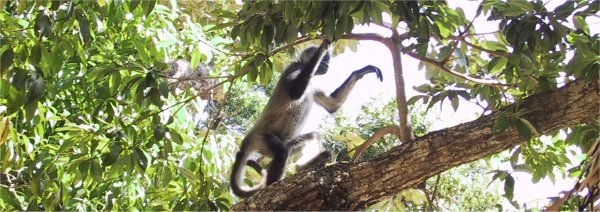
The drive to Aktun Chen is easy, although the park is a few miles off the main highway and is reached over a dirt road. On the way in, we almost scared the pants off a little spider monkey who tried to cross the path before us. A few minutes later, a large Iguana almost scared the pants off us, as it was his turn to cross the road. He wasn't very fast, but too fast for us to take a picture. A little further down the road is the parking area of the park, although "parking area" might not be the right term. One simply parks the car in the jungle wherever there is room. A warning sign reminds people to lock their cars, but not to keep people out. Apparently, the resident monkeys of the area have a playful streak and tend to open car doors and steal whatever they can. I assume mostly little things though. At least, I have never heard of a monkey getting far with a stolen car...
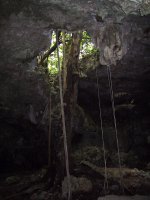
As we get to the "entrance" of the park (a little area with a roof), we actually get a demonstration of the monkeys playfulness. Several monkeys are climbing over cars and huts, trying to steel the tourists hats, and the cashiers credit card reader, among other things. It was great fun to watch, and just that part would have been worth the trip to Aktun Chen.
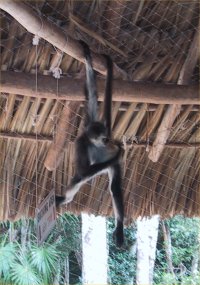
The attraction here is the guided tour however. It starts out with an introduction to local snakes, and (by accident) to some of the local spiders. The park also has some larger cats, such as a Cougar. The more interesting part however is the tour through the underground Cenote and cave system. Our tour guide was very friendly and knowledgeable. Also, the tour only had 6 people, which made it a very personalized experience.
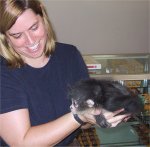
The cave system is relatively large for a Cenote. It is very interesting to get under the vegetation and see the actual root system of the above jungle as trees send their roots downwards until the reach water from the underground rivers. This part of the tour is better seen than described and ends with a fabulous site of the actual cenote, which is completely in the dark, but makes a great sight if lit up by a simple lighting system.
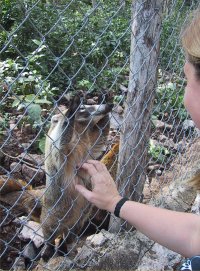
The guided tour ends in the wildlife park. One can see everything from wild turkeys to wild boars, and from parrots to monkeys. At the little snack bar (which actually served some decent fajitas), we played with several parrots that would come and sit on our arms if one would allow them to. The tucans on the other hand weren't quite as friendly. Several of them actually tried to bite me while I attempted to take a picture (and one almost succeeded).
Since we intended to move on to Dos Ojos right after Aktun Chen, we decided to eat at the snack bar, while everyone else moved on. Everyone besides the guide that is, who stopped there as well to have his lunch. By sheer coincidence, we ended up leaving at the same time as he did, which worked out great as he showed us around the park a bit more. Thanks to him, we ended up stopping at the monkey area for quite a while and played with some of the monkeys (one tried to steel the guide's flashlight... but we caught him in time...) and also raccoon-like animal (I can't recall the exact species...), which just loved to have its stomach petted.
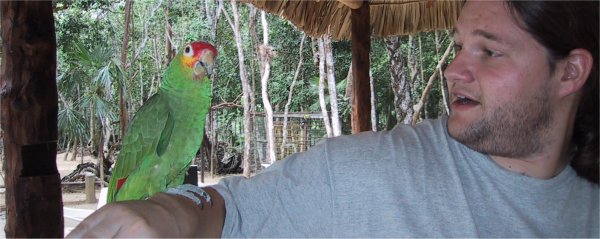
Actun Chen was en excellent experience, and we are still arguing whether or not this should rate as our top-experience of the trip.
Dos Ojos
After our visit to Actun Chen, we drove a few miles further south to visit Dos Ojos. This is a system of cenotes with two main entrances (hence the name "two eyes"). The "entrance" to this attraction is right at the main highway, although the actual site is further inland and can only be reached through one of the worst dirt road I've ever been on. Again, I hate to say it, but I was thankful that we had a rental car (despite my very careful driving) and I wouldn't have made this trip using my own car. In the end however, it was all worth it.
Unlike Actun Chen, the cave system of Dos Ojos is under water and can therefore only be visited if you are willing to snorkel or dive. We chose the snorkel version, since we aren't licensed scuba divers (which is a requirement to dive). While I am sure the diving version is much more impressive, snorkeling was quite an experience too, especially since 80% of the system is accessible for snorkelers. I do recommend to get a guide however, especially if you do not own your own underwater lights.

The whole snorkeling trip took about two hours and included both "eyes" as well as the bat cave. The first system we visited was much larger and leads us through several very narrow passages with extremely low ceilings. The underwater (and above water) formations were breathtaking, and the experience was much stronger than I could ever describe it in this article. I just couldn't get enough of going to the different caves, and explore what's around the next corner, and whether or not there is another cave system leading of somewhere deeper down (careful when you come back up... it is very hard to tell where the exact ceiling is!).
And the best part: Everybody can do this. While the prospect of diving or snorkeling in a cave may be scary to a lot of people, it really isn't! Swimming around in the cave is very easy, and especially for snorkelers, there are very few dangers. There are no crocodiles in the water. However, you will see fish. So the worst thing that could possibly happen is that you bang your head. The water temperature is perfect as well, making for a very enjoyable swim
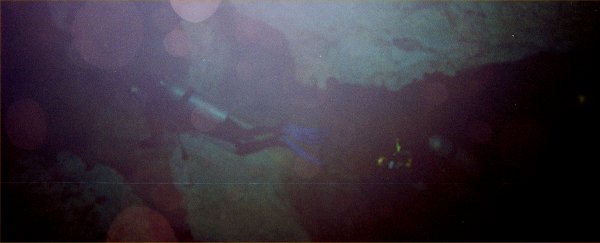
I promised myself to come back to Dos Ojos, if at all possible to dive. If I do so however, I will try to get there early in the morning (before all the tourists show up and the movement in the water causes the sediments to rise, lowering the visibility). Places like these make it so hard to decide which part of our trip to Mexico was the most enjoyable...
Snorkeling at the Maya Reef
The Rivera Maya is an excellent destination for scuba divers as well as snorkel enthusiasts. Unfortunately, the weather didn't cooperate very well, and due to the high winds, all the scuba and snorkel operations were closed most of the time. Our last day however had some excellent weather, and we were ready to go. Unfortunately, so were a lot of other people that have been waiting patently over the last 10 days or so, and despite the concierge's best effort, we were not able to book a snorkel trip to the Maya Reef, which was less than half a mile off the beach right in front of our hotel. Luckily, we ended up getting out to the reef after all, by simply walking up to one of the snorkel boats as it came to the beach to drop of the previous load of tourists. The guide agreed to take us out to the reef for 25 bucks each. We ended up sharing the boat with only three other people.
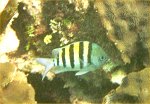
To make a long story short, the experience was breath-taking! Within the two hour trip, we went to two different locations where we snorkeled for about 45 minutes each. We saw thousands and thousands of colorful reef fish, who's names I couldn't even begin to imagine. Among the few species I managed to identify (sometimes with the help of our guide) were Trumpet Fish, Parrot Fish, Star Fish, and others. As for the bigger species, we saw Barracudas (perhaps just over 2 feet in length), which our guide attracted with the help of his snorkel. We also saw a few tortoises, one of which our guide caught for us and let us touch. It was about a foot in length (or perhaps a little more when it stuck its head out all the way), and after an initial struggle to get away, it didn't seem to nervous, and seemed to be more curious than scared. I am not sure what marine biologists would say about touching a tortoise, but it certainly was a great experience, We petted its back and nose, and then the guide carefully returned it back to the exact spot in which it came from.

Perhaps the biggest thrill came just before the end of our excursion to the Maya reef, when an Eagle Ray slowly seemed to fly through the water, just about 10 feet from us. It's wing span was about 3 to 4 feet, and I would guess that the whole animal was about 6 to 7 feet in length, counting its tail.
Going Home...
As I am writing these lines, we have already packed and we will be on our way home to Houston tomorrow morning. As always, I am not looking forward to the trip. Too comfortable was I here, and too exciting were the things we did. I am ready to go back to the cenotes or the Maya Reef. I am ready to see Uxmal and some of the other archeological sites. I am ready to go back and party in Playa del Carmen, and I am ready to do many of the things we didn't have enough time for...
This trip truly was an eye-opener to the beauty of Mexico. I was pleasantly surprised by the country, and perhaps even more so by its people. I was surprised how gentle and friendly all the people were I met. I was surprised how good the service was. We will be back in the not too distant future. After all, Cancun is only a short flight from Houston, making it possible to fly down just for a long weekend. I will try to avoid the high season though. From what I am told, May as well as September and October are the best time to come. I have already marked the date on my calendar...
Markus Egger
Getting There
The easiest way to get to Puerto Morelos (or the area in general) is to fly into Cancun. Flights from Houston, Atlanta, and other US hubs appear to be scheduled several times a day. The flight from Houston took us just under 2 hours.
For more information on the Ceiba del Mar Hotel, visit their web site at Http://www.CeibaDelMar.com.
For more information on Puerto Morelos visit:
